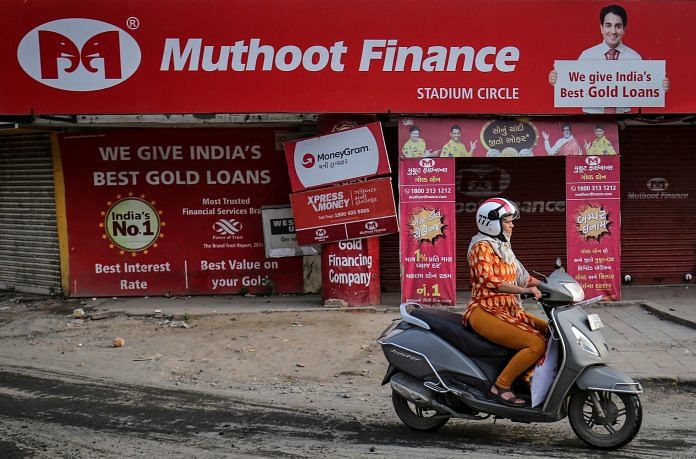New Delhi: Bank credit grew by 11.9 per cent over the first nine months of this financial year, driven by particularly strong growth in personal loans and loans to the services sector, analysis by Bank of Baroda has shown.
The report, released on 4 February and accessed by ThePrint, measures the level of credit in December relative to its level in March of that year. It shows that while other key areas of the economy are increasing their loan offtake by double-digits, the overall manufacturing sector — especially large industry — is lagging behind.
“Overall growth in credit was 11.9 per cent,” Bank of Baroda’s note said. “Interestingly, growth for manufacturing was lower at 4.3 per cent, reflecting lower level of activity. Within manufacturing, large industry was an under-performer with growth of just 2.7 per cent. Medium industry grew by 11 per cent and small by 8.7 per cent.”
However, it is important to note that although credit to industry is exhibiting relatively slow growth, it still makes up a significant share of bank credit. Credit to industry still formed 24.7 per cent of overall credit given by banks in December 2022, although it was lower than the figure for March 2022 (26.5 per cent).
This decline in the share of industry as a receiver of credit is driven by a commensurate rise in the shares of both the personal loans category and the services sector — an indication that consumption is getting back on track, as are contact-intensive sectors of the economy.
It’s significant to note that the report also highlighted the fact that credit growth was taking place despite the rate hikes conducted by the Reserve Bank of India (RBI). The RBI has hiked interest rates by 225 basis points since May 2022 to 6.25 per cent, and is expected to hike it by another 25 basis points in its Monetary Policy Committee announcement Wednesday.
“Going ahead, the overall liquidity situation needs to be tracked as surpluses have dwindled to a near-neutral state,” the note said. “The RBI policy will be watched in this regard. The MPC would persist with another rate hike to bring the repo rate to 6.5 per cent for this cycle before a pause.”
Also Read: Budget 2023: Fiscal deficit to meet 6.4% target in FY23, aim for 5.9% in FY24, says Sitharaman
The growth of personal loans
The overall growth in credit to the personal loans category stood at 16.4 per cent in December over March 2022, a significant jump from the growth of 9 per cent in the same period of the previous year.
Within this, advances against fixed loans — where borrowers use their fixed loans as collateral for loans — saw the strongest growth of 39.6 per cent against a growth of 9.5 per cent in the previous year. Personal loans for the acquisition of consumer durables also saw very strong growth of 32.6 per cent in December over March 2022, although this was slower than the 45.4 per cent growth seen in the same period of the previous year.
“Loans against jewellery, fixed deposits and shares & bonds were also up, reflecting, to an extent, the rise of consumerism in the country where households were willing to borrow to meet consumption requirements,” the research note said.
Vehicle loans also saw strong growth of 20.4 per cent, as did the outstanding amounts on credit cards (21.9 per cent).
Overall, the personal loans category made up nearly 30 per cent of all loans given in December 2022, up from 28.4 per cent in March 2022.
Services sector picking up
The services sector also saw strong credit growth in December 2022, growing by 16.2 per cent over March 2022.
Within this, the bulk of the growth was driven by loans given to non-banking financial companies (NBFCs), which saw a credit growth of 29.1 per cent. This is especially significant because NBFCs then use these funds to give loans to lower-income households.
“Services credit was driven by NBFCs (29.1 per cent) followed quite distantly by trade, transport operators, and professional services,” the report said. “Quite clearly, the revival in the services sector with the complete opening up post lockdowns from April onwards were accompanied by heightened activity with the PMIs (Purchasing Managers Index, a measure of business activity) increasing.”
The services sector also saw its share in overall credit growing to 26.3 per cent in December 2022 from 25.4 per cent in March 2022.
“The important takeaway here is that the top five sectors which need to be followed closely by the banking system as they drive top-line growth are large industry (18.6 per cent), housing (14.3 per cent), NBFCs (9.9 per cent), trade (5.8 per cent) and vehicle loans (3.6 per cent),” the report added.
(Edited by Uttara Ramaswamy)
Also Read: ‘Recovery complete’: Economic Survey pegs India’s growth at 6.5% in FY24, and faster thereafter



